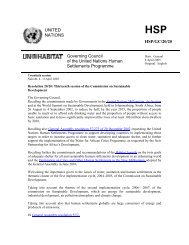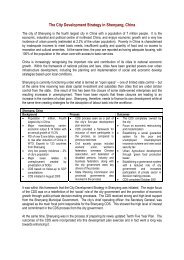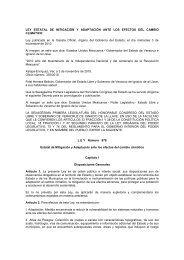Planning for Climate Change - UN-Habitat
Planning for Climate Change - UN-Habitat
Planning for Climate Change - UN-Habitat
Create successful ePaper yourself
Turn your PDF publications into a flip-book with our unique Google optimized e-Paper software.
<strong>Planning</strong> <strong>for</strong> <strong>Climate</strong> <strong>Change</strong>: A Strategic, Values-based Approach<br />
2.0 <strong>Planning</strong> <strong>for</strong> <strong>Climate</strong> <strong>Change</strong>:<br />
A Strategic, Values-based Approach<br />
Addressing climate change is a daunting challenge. When coupled with large vulnerable<br />
populations, in<strong>for</strong>mal land and housing development, infrastructure limitations<br />
and poverty, the challenge of responding to climate change can at first appear<br />
overwhelming.<br />
With so many challenges already at hand, how can urban planners be expected to also<br />
plan <strong>for</strong> and take action on climate change? Where does climate change ‘fit’ in terms<br />
of a city’s priorities? What sectoral plans should include and/or address climate<br />
change? How?<br />
2.1 THE PLANNING FRAMEWORK<br />
This guide takes the approach that climate change planning can, and should, augment<br />
and be integrated with existing planning and development activities across all sectors.<br />
<strong>Climate</strong> change is simply another key piece of in<strong>for</strong>mation that should be considered<br />
during every planning process, to modify plans and to provide additional cost-benefit<br />
rationale <strong>for</strong> these modifications. Many climate change planning actions are consistent<br />
with planners’ responsibilities, including:<br />
<br />
<br />
<br />
<br />
<br />
<br />
Minimizing and/or improving housing and land development activities that<br />
occur in flood and slope hazard areas;<br />
Improving infrastructure <strong>for</strong> storm water management, solid and liquid waste<br />
management, access to safe drinking water, and the movement of goods and<br />
people;<br />
Protecting habitat and environmentally-sensitive areas in and around towns and<br />
cities;<br />
Improving emergency response capacities <strong>for</strong> disasters (particularly weather and<br />
climate-related events);<br />
Supporting local economic development to reduce poverty and improve quality<br />
of life; and,<br />
Supporting more sustainable development.<br />
To help integrate climate change planning into current planning and urban development<br />
initiatives, and make it easier <strong>for</strong> town planners to take action on climate change, this<br />
A Strategic, Values-based Approach <strong>for</strong> Urban Planners<br />
19

















